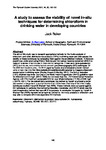A study to assess the viability of novel in-situ techniques for determining chloroform in drinking water in developing countries
| dc.contributor.author | Baker, J. | |
| dc.date.accessioned | 2021-12-24T17:19:16Z | |
| dc.date.available | 2021-12-24T17:19:16Z | |
| dc.date.issued | 2021 | |
| dc.identifier.citation |
Baker, J. (2021) 'A study to assess the viability of novel in-situ techniques for determining chloroform in drinking water in developing countries', The Plymouth Student Scientist, 14(2), pp. 160-190. | en_US |
| dc.identifier.uri | http://hdl.handle.net/10026.1/18503 | |
| dc.description.abstract |
The aim of this study was to research appropriate methods for the in-situ analysis of chloroform and other disinfection by-products (DBPs) in drinking water and then assess the viability of these techniques by comparing them against the established methods. A literature search was undertaken using Web of Science and the various features contained within it to research a series of techniques in three distinct categories. These were βeta-cyclodextrin (βCD) techniques, colourimetry techniques and gas-chromatography (GC) techniques. Of the βCD techniques studied, the 2014 paper by Ncube et al showcased a novel method using an azo dye modified βeta-cyclodextrin epichlorohydrin polymer to measure chloroform concentration in drinking water (Ncube, Krause & Mamba, 2014). The limit of detection (LOD) obtained was lower than that of the World Health Organisation (WHO) guideline value for chloroform of 0.3 mg/L (WHO, 2008) but not lower than the U.S Environmental Protection Agency (USEPA) maximum acceptable limit for total trihalomethanes (TTHM) of 0.08 mg/L (USEPA, 2021). For the colourimetry techniques the method by Fattahi et al used a cotton pad soaked in reagents to quantify chloroform at LOD’s lower than any of the other in-situ techniques studied (Fattahi & Shariati-Rad, 2020). These methods were compared against GC techniques in particular the method by González-Hernández et al (2017) which was the most inexpensive method that was still fit for purpose. In conclusion the paper by Fattahi & Shariati-Rad (2020) represented an optimal method for the in-situ analysis of chloroform and was able to compete with more expensive GC methods. | en_US |
| dc.language.iso | en | en_US |
| dc.publisher | University of Plymouth | en_US |
| dc.rights | Attribution 3.0 United States | * |
| dc.rights.uri | http://creativecommons.org/licenses/by/3.0/us/ | * |
| dc.subject | Chloroform | en_US |
| dc.subject | disinfection by-product | en_US |
| dc.subject | beta-cyclodextrin | en_US |
| dc.subject | fluorescence | en_US |
| dc.subject | colourimetry | en_US |
| dc.subject | Fujiwara | en_US |
| dc.subject | GC-MS | en_US |
| dc.subject | GC-ECD | en_US |
| dc.subject | GC-FID | en_US |
| dc.title | A study to assess the viability of novel in-situ techniques for determining chloroform in drinking water in developing countries | en_US |
| dc.type | Article | en_US |
| plymouth.issue | 2 | |
| plymouth.volume | 14 | |
| plymouth.journal | The Plymouth Student Scientist |



